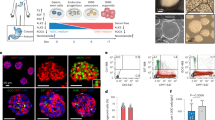Abstract
Most patients with type 1 diabetes rely on multiple daily insulin injections to maintain blood glucose control. However, insulin injections carry the risk of inducing hypoglycemia and do not eliminate diabetic complications. We sought to develop and evaluate a regulatable cell-based system for delivery of insulin to treat diabetes. We generated two intestinal cell lines in which human insulin expression is controlled by mifepristone. Insulin mRNA expression was dependent on the mifepristone dose and incubation time and cells displayed insulin and C-peptide immunoreactivity and glucose-induced insulin release following mifepristone treatment. Cell transplantation followed by mifepristone administration reversed streptozotocin (STZ)-induced diabetes in mice, and this effect was dependent on the mifepristone dose delivered. These data support the notion that engineering regulatable insulin expression within a cell already equipped for regulated secretion may be efficacious for the treatment of insulin-dependent diabetes.






Similar content being viewed by others
References
Shapiro AM, Lakey JR, Ryan EA, Korbutt GS, Toth E, Warnock GL, Kneteman NM, Rajotte RV (2000) Islet transplantation in seven patients with type 1 diabetes mellitus using a glucocorticoid-free immunosuppressive regimen. N Engl J Med 343:230–238
King AJ, Fernandes JR, Hollister-Lock J, Nienaber CE, Bonner-Weir S, Weir GC (2007) Normal relationship of beta- and non-beta-cells not needed for successful islet transplantation. Diabetes 56:2312–2318
Pipeleers DG, Pipeleers-Marichal M, Hannaert JC, Berghmans M, In't Veld PA, Rozing J, Van de Winkel M, Gepts W (1991) Transplantation of purified islet cells in diabetic rats. I. Standardization of islet cell grafts. Diabetes 40:908–919
Kroon E, Martinson LA, Kadoya K, Bang AG, Kelly OG, Eliazer S, Young H, Richardson M, Smart NG, Cunningham J, Agulnick AD, D'Amour KA, Carpenter MK, Baetge EE (2008) Pancreatic endoderm derived from human embryonic stem cells generates glucose-responsive insulin-secreting cells in vivo. Nat Biotechnol 26:443–452
Liew CG, Shah NN, Briston SJ, Shepherd RM, Khoo CP, Dunne MJ, Moore HD, Cosgrove KE, Andrews PW (2008) PAX4 enhances beta-cell differentiation of human embryonic stem cells. PLoS ONE 3:e1783
Mas A, Montane J, Anguela XM, Munoz S, Douar AM, Riu E, Otaegui P, Bosch F (2006) Reversal of type 1 diabetes by engineering a glucose sensor in skeletal muscle. Diabetes 55:1546–1553
Thule PM, Campbell AG, Kleinhenz DJ, Olson DE, Boutwell JJ, Sutliff RL, Hart CM (2006) Hepatic insulin gene therapy prevents deterioration of vascular function and improves adipocytokine profile in STZ-diabetic rats. Am J Physiol Endocrinol Metab 290:E114–E122
Thule PM, Liu J, Phillips LS (2000) Glucose regulated production of human insulin in rat hepatocytes. Gene Ther 7:205–214
Chen NK, Sivalingam J, Tan SY, Kon OL (2005) Plasmid-electroporated primary hepatocytes acquire quasi-physiological secretion of human insulin and restore euglycemia in diabetic mice. Gene Ther 12:655–667
Rivera VM, Clackson T, Natesan S, Pollock R, Amara JF, Keenan T, Magari SR, Phillips T, Courage NL, Cerasoli F Jr, Holt DA, Gilman M (1996) A humanized system for pharmacologic control of gene expression. Nat Med 2:1028–1032
Rivera VM, Wang X, Wardwell S, Courage NL, Volchuk A, Keenan T, Holt DA, Gilman M, Orci L, Cerasoli F Jr, Rothman JE, Clackson T (2000) Regulation of protein secretion through controlled aggregation in the endoplasmic reticulum. Science 287:826–830
Cataland S, Crockett SE, Brown JC, Mazzaferri EL (1974) Gastric inhibitory polypeptide (GIP) stimulation by oral glucose in man. J Clin Endocrinol Metab 39:223–228
Kieffer TJ, Buchan AM, Barker H, Brown JC, Pederson RA (1994) Release of gastric inhibitory polypeptide from cultured canine endocrine cells. Am J Physiol 267:E489–496
Parker HE, Habib AM, Rogers GJ, Gribble FM, Reimann F (2009) Nutrient-dependent secretion of glucose-dependent insulinotropic polypeptide from primary murine K cells. Diabetologia 52:289–298
Cheung AT, Dayanandan B, Lewis JT, Korbutt GS, Rajotte RV, Bryer-Ash M, Boylan MO, Wolfe MM, Kieffer TJ (2000) Glucose-dependent insulin release from genetically engineered K cells. Science 290:1959–1962
Han J, Lee HH, Kwon H, Shin S, Yoon JW, Jun HS (2007) Engineered enteroendocrine cells secrete insulin in response to glucose and reverse hyperglycemia in diabetic mice. Mol Ther 15:1195–1202
Wang Y, O'Malley BW Jr, Tsai SY, O'Malley BW (1994) A regulatory system for use in gene transfer. Proc Natl Acad Sci USA 91:8180–8184
Fujita Y, Cheung AT, Kieffer TJ (2004) Harnessing the gut to treat diabetes. Pediatr Diabetes 5(Suppl 2):57–69
Halban PA, Kahn SE, Lernmark A, Rhodes CJ (2001) Gene and cell-replacement therapy in the treatment of type 1 diabetes: how high must the standards be set? Diabetes 50:2181–2191
Olson DE, Paveglio SA, Huey PU, Porter MH, Thule PM (2003) Glucose-responsive hepatic insulin gene therapy of spontaneously diabetic BB/Wor rats. Hum Gene Ther 14:1401–1413
Papas KK, Colton CK, Nelson RA, Rozak PR, Avgoustiniatos ES, Scott WE 3rd, Wildey GM, Pisania A, Weir GC, Hering BJ (2007) Human islet oxygen consumption rate and DNA measurements predict diabetes reversal in nude mice. Am J Transplant 7:707–713
Truong W, Emamaullee JA, Merani S, Anderson CC, James Shapiro AM (2007) Human islet function is not impaired by the sphingosine-1-phosphate receptor modulator FTY720. Am J Transplant 7:2031–2038
Weitgasser R, Davalli AM, Weir GC (1999) Measurement of glucose concentrations in rats: differences between glucose meter and plasma laboratory results. Diabetologia 42:256
Acknowledgements
TJK is a Michael Smith Foundation for Health Research (MSFHR) senior scholar and received grant funding from the Juvenile Diabetes Research Foundation and MSFHR. SU received post-doctoral fellowships from the Canadian Institutes of Health Research and MSFHR, and RDW received scholarship support from MSFHR and the Natural Sciences and Engineering Research Council of Canada. We thank Anastasia Vlasova for expert technical assistance and acknowledge the National Hormones and Peptides Program, National Institutes of Diabetes and Digestive and Kidney Diseases, and Dr. A.F. Parlow for provision of mifepristone.
Conflict of interests statement
The authors declare that they have no competing financial interests.
Author information
Authors and Affiliations
Corresponding author
Rights and permissions
About this article
Cite this article
Unniappan, S., Wideman, R.D., Donald, C. et al. Treatment of diabetes by transplantation of drug-inducible insulin-producing gut cells. J Mol Med 87, 703–712 (2009). https://doi.org/10.1007/s00109-009-0465-0
Received:
Revised:
Accepted:
Published:
Issue Date:
DOI: https://doi.org/10.1007/s00109-009-0465-0




